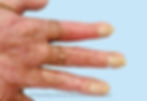Addressing Post-Burn Fingernail Deformities Caused by Dorsal Scar Contractures
- Sunshine Foundation
- Jun 10
- 4 min read
Updated: Jul 6

Why We Cannot Overlook Post-Burn Fingernail Deformities
Post-burn fingernail deformities resulting from dorsal hand burn scar contractures are often underappreciated but have profound implications for burn survivors. Beyond being a cosmetic concern, these deformities can affect hand function, exacerbate physical limitations, and diminish the quality of life. The hands are essential for daily activities, and even minor impairments can result in reduced independence, frustration, and psychological distress. In this article, we examine the physical and functional impact of post-burn fingernail deformities, as well as what are the interventions to prevent or manage fingernail deformities.
What Are Post-Burn Fingernail Deformities

Fingernail deformities are a frequent complication after burn injury to the dorsum of the hand. The deformity can be the result of the direct injury to the nail bed or germinal matrix, but oftentimes, it is secondary to scar contracture on the dorsum of the hand. The tension of scars that extend from the dorsum of the hand to fingers will pull the soft tissue proximal to the nail fold, leading to exposure of the germinal matrix and causing abnormal nail growth.
What Are the Physical and Functional Impact of Fingernail Deformities
Scar contracture on the dorsum of the hand creates a proximal-pulling tension on the skin and underlying structures, causing abnormal nail growth. This can result in ridges, splitting, or ingrown nails, which can be a cosmetic concern. But more importantly, excess tension across the dorsal side of fingers will often restrict DIP flexion, while the pull of scars on the soft tissue proximal to the nail fold leads to exposure of the germinal matrix, making finger manipulation painful.

Contractures limit joint mobility, restricting critical movements like grasping, pinching, or extending the fingers. This directly hampers the hand’s ability to perform daily tasks. Hypersensitivity or pain also discourages the use of the hand, leading to further stiffness and disuse. Simple tasks like picking up objects with fingers or buttoning a shirt become difficult and painful. Visible deformities can also cause embarrassment or social stigma, affecting the patient’s body image and by extension, his willingness to engage socially.
How to Prevent and Manage Fingernail Deformities
Since dorsal scar contracture increases the risk of fingernail deformity, early management of dorsal scars is essential. This is done through interventions like finger flexion exercises aimed at stretching and elongating the scar to counteract the force of contracture.
However, there are two important points to note:
For exercises targeting DIP flexion, active exercises are acceptable, but passive exercises should be avoided. The ligaments and tendons of the DIP joint are prone to rupture from passive stretching. For more details, refer to the article Exercises for the Distal Interphalangeal Joint? Use Caution and Avoid Passive Flexion Exercises!
During exercise, it’s important to identify the source of pain. If the patient reports pain that feels like pulling at the nail bed, greater emphasis should be placed on pressure therapy to control and soften scars as mentioned below, or consulting a physician about the possibility of surgical intervention.
Pressure therapy using pressure garments can control hypertrophic scarring and reduce pulling tension on the fingernail. Additionally, applying silicone gel sheets or hydrocolloidal sheets directly to the base of the fingernail area can soften the scar and alleviate tension on the nail bed itself.

Maintaining skin and nail health is equally important. Regularly moisturizing scars helps maintain skin elasticity and reduces the risk of cracking, while proper nail care, including gentle trimming, prevents splitting, ingrown nails, and infections.
However, in case of severe contractures, surgical interventions, such as release procedures, skin grafting, or reconstructive surgeries, may be necessary to restore functionality and relieve tension on the fingernail.
Conclusion
Although nail bed deformities may seem like a minor problem, they are highly problematic for burn patients due to the functional limitations and, especially, the pain they cause. These issues can profoundly impact a patient’s quality of life, making it crucial for therapists to address them proactively. When dealing with hand burns, particularly those on the dorsum, therapists must not forget strategies to prevent fingernail deformities. By doing so, they can help patients regain hand functionality, reduce pain, and improve their overall well-being.
References:
Donelan, M. B., & Garcia, J. A. (2006). Nailfold reconstruction for correction of burn fingernail deformity. Plastic and reconstructive surgery, 117(7), 2303–2309.
Sorkin, M., Cholok, D., & Levi, B. (2017). Scar Management of the Burned Hand. Hand clinics, 33(2), 305–315.
Spauwen, P. H., Brown, I. F., Sauer, E. W., & Klasen, H. J. (1987). Management of fingernail deformities after thermal injury. Scandinavian Journal of Plastic and Reconstructive Surgery, 21(3), 253-255.
Srivastava, Vaishali & Sharma, Upendra & Rathore, Deepak. (2022). Study of Yang's Onion Flap Technique for Release of Scarred Eponychium and Nail Fold Reconstruction in Burn Patients. Indian Journal of Plastic Surgery. 55. 282-286. 10.1055/s-0042-1756125.
Yang, J. Y., Yang, S. Y., & Chen, W. F. (2012). "Onion" flap: a novel technique for reconstruction of burn nail deformities. The journal of trauma and acute care surgery, 72(5), 1424–1428.
